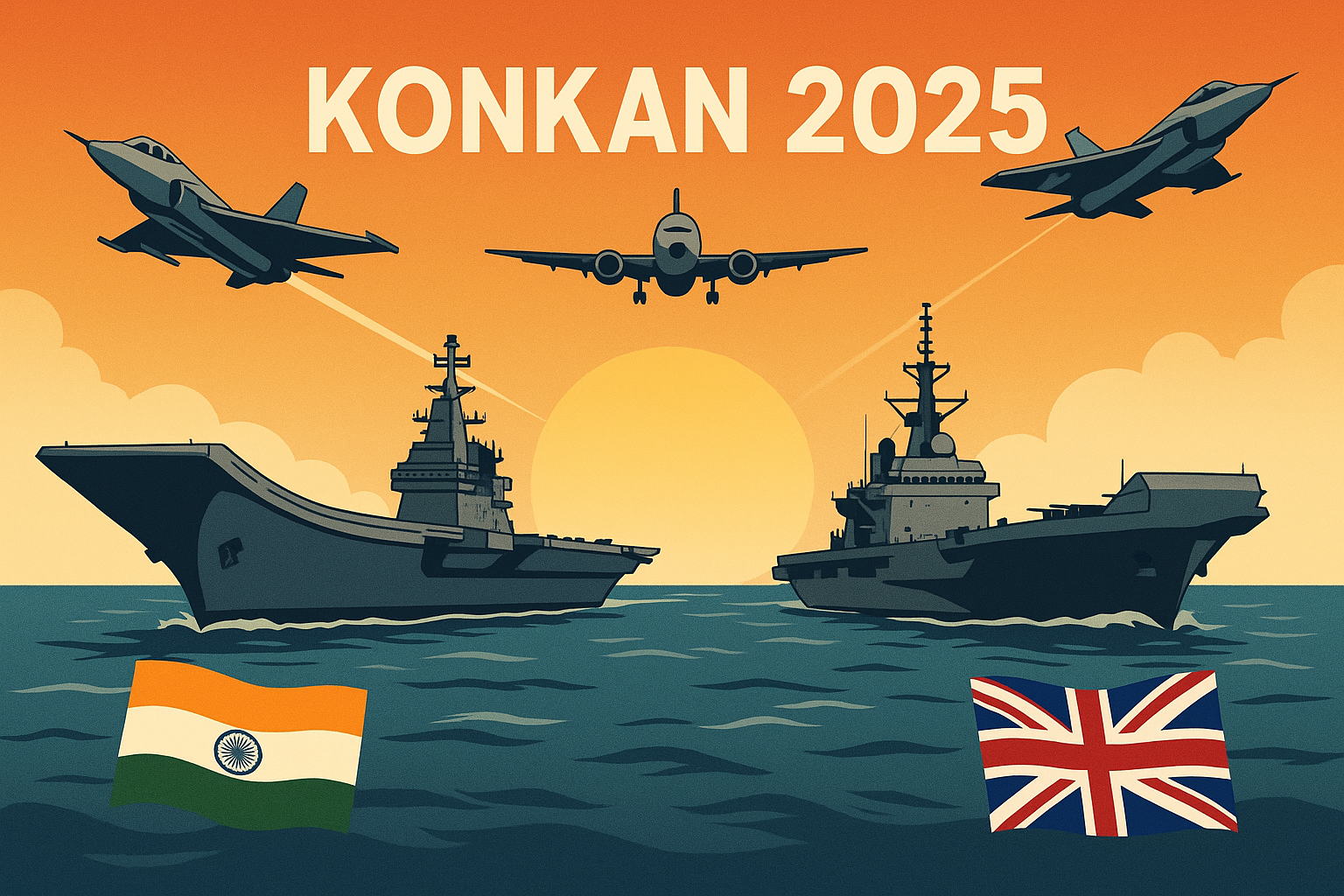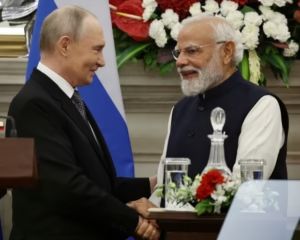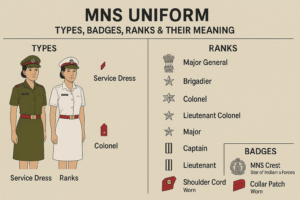Introduction
“Konkan 2025” marks one of the most significant naval collaborations between India and the United Kingdom. Conducted off India’s western seaboard, the exercise symbolizes not just military partnership but a broader strategic, technological, and geopolitical alignment in the evolving Indo-Pacific order. Beyond the maritime drills, it reflects India’s growing confidence as a blue-water navy capable of coordinating large-scale joint operations with major powers.
1. What is Exercise KONKAN?
Background
Exercise KONKAN is a bilateral naval exercise between the Indian Navy and the Royal Navy of the United Kingdom. It has been conducted regularly for over two decades to strengthen interoperability, tactical coordination, and mutual understanding between the two maritime forces.
Objectives
Strengthen operational synergy between the two navies
Conduct advanced air, surface, and sub-surface warfare drills
Exchange best practices in carrier and anti-submarine operations
Reinforce India–UK maritime cooperation in the Indian Ocean Region (IOR)
2. Highlights of Konkan 2025
Timeline & Participation
The 2025 edition was held in October 2025 off the western coast of India, focusing on large-scale maritime and air coordination. It featured:
Indian Navy’s INS Vikrant Carrier Strike Group
Royal Navy’s HMS Prince of Wales Carrier Strike Group
Anti-submarine warfare aircraft, destroyers, frigates, and helicopters from both sides
Key Milestones
First-ever combined carrier operations between India and the UK
Beyond Visual Range (BVR) air combat and tactical air warfare drills
Advanced anti-submarine, air-defence, and surface warfare training
Live coordination between carrier-based fighters and long-range maritime patrol aircraft
Diplomatic Context
Konkan 2025 coincided with renewed strategic dialogue under the India–UK Vision 2035, focusing on maritime security, defence technology, and shared Indo-Pacific objectives.
3. Strategic and Geopolitical Significance
Strengthening India’s Maritime Posture
The Konkan coast represents India’s critical western maritime flank, guarding vital trade routes through the Arabian Sea. The 2025 exercise showcased India’s growing capacity for joint power projection and multi-domain operations.
India–UK Strategic Partnership
KONKAN 2025 deepens the India–UK Comprehensive Strategic Partnership, aligning both countries’ naval doctrines toward a free, open, and rules-based Indo-Pacific. It enhances interoperability and solidifies the two nations as key maritime security partners.
Regional Deterrence
The combined carrier operations send a clear message of strength and preparedness, reinforcing deterrence in the Indian Ocean Region amid rising geopolitical competition.
4. Technological and Operational Innovations
Carrier Integration
For the first time, both nations integrated their carrier air groups for coordinated missions — including simulated strikes, electronic warfare drills, and coordinated take-offs/landings.
Multi-Domain Warfare
KONKAN 2025 covered every operational domain:
Surface warfare using destroyers and frigates
Submarine tracking and anti-submarine warfare (ASW)
Aerial refuelling and advanced BVR air combat exercises
Network-centric warfare operations using encrypted data links and real-time command coordination
Technological Highlights
Integration of AI-enabled command systems for fleet management
Enhanced radar, sonar, and satellite-based maritime domain awareness (MDA)
Use of unmanned aerial systems (UAS) for reconnaissance and threat assessment
5. Regional and Developmental Impact
Although primarily a defence exercise, Konkan 2025 creates ripple effects across the regional economy and infrastructure.
Infrastructure Boost
Ports and naval bases along the Konkan coast are being upgraded to handle carrier-sized vessels, logistics support, and fuel management systems. This indirectly benefits civilian maritime infrastructure and local trade networks.
Economic & Tourism Opportunities
High-profile exercises bring logistical contracts, ship repair, catering, and hospitality business to coastal towns like Ratnagiri, Sindhudurg, and Goa. Increased visibility promotes tourism and coastal economy development.
Educational and Skill Development
Maritime institutions and naval academies use these exercises to train cadets in advanced naval doctrines, boosting local technical skill levels.
6. Environmental and Maritime Security Dimensions
Balancing Strategy and Ecology
The Konkan coast is environmentally sensitive — home to mangroves, fisheries, and coral ecosystems. Exercise planners ensured environmental safeguards, restricting live-fire drills near sensitive coastal zones.
Addressing Maritime Threats
The region faces threats like piracy, illegal trafficking, and unregulated fishing. Exercises like KONKAN 2025 strengthen surveillance and rapid-response capabilities to ensure maritime security and freedom of navigation.
Climate Adaptation
Seasonal cyclones and monsoons challenge naval operations. Lessons from Konkan 2025 will shape climate-adaptive naval planning, ensuring operational readiness in changing oceanic conditions.
7. Challenges and Critiques
Operational Complexity: Coordinating two carrier strike groups with different communication protocols demands intense planning.
Financial Burden: Deploying carriers and support fleets for a week-long exercise requires substantial expenditure.
Environmental Concerns: Naval activity may temporarily affect marine habitats; long-term monitoring is essential.
Symbolism vs. Substance: Some analysts argue that while the exercise sends strong signals, consistent long-term cooperation matters more.
8. The Road Ahead: Post-2025 Outlook
Multilateral Expansion: India may expand KONKAN into a quadrilateral format with allies like Japan, Australia, and France.
Technology Sharing: Collaboration in AI, ship-borne drones, and stealth systems is expected to grow.
Logistics Agreements: Deeper integration through reciprocal logistics and support agreements will improve efficiency.
Maritime Domain Awareness (MDA): Joint satellite and sensor-based monitoring systems will boost regional security.
Local Benefits: Port modernization, enhanced coastal security, and skill development are long-term outcomes.
9. SEO Optimization Summary
Primary Keyword: Konkan 2025
Secondary Keywords: Exercise Konkan, India–UK Naval Exercise, Indian Navy, Royal Navy, Carrier Operations 2025, Maritime Security, Konkan Coast
Readability: Structured with H2/H3 headings, bullet points, and concise paragraphs.
Meta Description Example:
“Konkan 2025 — India and UK conduct their first combined carrier strike group operations, strengthening maritime security and Indo-Pacific cooperation.”
10. FAQ on Konkan 2025
Q1. What is Konkan 2025?
Konkan 2025 is the bilateral naval and air exercise between the Indian Navy and the Royal Navy, held off India’s western coast to enhance maritime interoperability and security cooperation.
Q2. Why is it called ‘Konkan’?
It is named after the Konkan region — the coastal stretch of Maharashtra and Goa — where the exercise is conducted.
Q3. What made Konkan 2025 unique?
It featured the first combined carrier operations between India and the UK, along with BVR air warfare, submarine hunting, and multi-domain command integration.
Q4. How does Konkan 2025 benefit India strategically?
It strengthens India’s maritime dominance, boosts its defence ties with the UK, and reinforces its strategic role in the Indo-Pacific region.
Q5. Are there environmental risks involved?
Large-scale naval exercises can affect marine ecosystems, but mitigation protocols like restricted zones and controlled sonar use help reduce the impact.
Q6. Will there be more Konkan exercises in the future?
Yes. The success of Konkan 2025 has set the stage for deeper India–UK cooperation, possibly evolving into multilateral Indo-Pacific maritime exercises.
Q7. Does it help regional development?
Yes. Coastal infrastructure upgrades, local economic activity, and maritime education benefit indirectly from such large-scale international exercises.
✅ Conclusion
Konkan 2025 stands as a landmark in India–UK naval collaboration — not just as a demonstration of power, but as a reflection of trust, technology sharing, and maritime strategy. It strengthens India’s role as a guardian of the Indian Ocean, balancing security with development along its historic Konkan coast.






